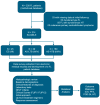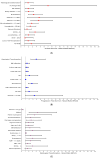Clinical-Demographic Profile, Prognostic Factors and Outcomes in Classic Follicular Lymphoma Stratified by Staging and Tumor Burden: Real-World Evidence from a Large Latin American Cohort
- PMID: 39682103
- PMCID: PMC11640734
- DOI: 10.3390/cancers16233914
Clinical-Demographic Profile, Prognostic Factors and Outcomes in Classic Follicular Lymphoma Stratified by Staging and Tumor Burden: Real-World Evidence from a Large Latin American Cohort
Abstract
Background: Clinical staging (CS) and tumor burden (TB) play a significant role in FL prognosis and direct its up-front therapy. The aim of this study is to report prognostic factors and clinical outcomes in newly-diagnosed FL patients stratified according to CS and TB in early-stage (ES) disease, advanced-stage with low tumor burden (AS-LTB) and advanced-stage with high tumor burden (AS-HTB). Methods: Two hundred fourteen patients with FL grades 1-3A had baseline clinical characteristics and outcomes assessed. Survival according to up-front immunochemotherapeutic (ICT) regimens was assessed in the AS-HTB subgroup. Independent predictors for OS, PFS, POD-24, and Histological Transformation (HT) were identified. Results: Seventy-five percent of cases were categorized as AS-HTB, 13.5% as AS-LTB and 11.5% as ES. With a median follow-up of 8.15 years, the estimated 5-year OS and PFS were 75.4% and 57.2%, respectively. OS, but not PFS was markedly decreased in AS-HTB FL patients compared to ES and AS-LTB cases. POD-24 rate was 21.7% and overall mortality rate was 38.7% during the entire follow-up. The annual cumulative rate of HT to high-grade B-cell lymphoma (HGBCL) was 0.5%, and higher in AS-HTB cases, in comparison to ES and AS-LTB. Considering patients with AS-HTB there were no differences in clinical outcomes among cases submitted to ICT based on R-CHOP, R-CVP and regimens containing purine analogs. Additionally, ECOG ≥ 2, hypoalbuminemia, B-symptoms and HT were independently associated with poor survival. High content of centro-blasts (grade 3A), involvement of ≥3 nodal sites by FL and rituximab omission in up-front therapy predicted POD-24. Conclusions: FL has marked clinical-prognostic heterogeneity, translated into diverse CS and TB subcategories. Here, we demonstrated that FL patients classified as AS-HTB demonstrated decreased survival and higher rates of HT to HGBCL compared to ES and AS-LTB cases. Prognostic factors identified in our analysis may help to identify FL patients with higher-risk of HT and early-progression (POD-24).
Keywords: clinical outcomes; follicular lymphoma (FL); histological transformation (HT) to high-grade B-cell lymphoma (HGBCL); prognostic factors; progression of disease within 24 months from initial therapy (POD-24); staging; treatment modalities; tumor burden.
Conflict of interest statement
The authors declare no conflicts of interest. The funders had no role in the design of the study; in the collection, analyses, or interpretation of data; in the writing of the manuscript; or in the decision to publish the results.
Figures






Similar articles
-
Clinical features and outcomes of patients with follicular lymphoma: A real-world study of 926 patients in China.Front Oncol. 2022 Sep 16;12:863021. doi: 10.3389/fonc.2022.863021. eCollection 2022. Front Oncol. 2022. PMID: 36185179 Free PMC article.
-
[Follicular lymphoma: first - line selection criteria of treatment].Ter Arkh. 2019 Aug 15;91(8):75-83. doi: 10.26442/00403660.2019.08.000388. Ter Arkh. 2019. PMID: 32598757 Russian.
-
[Clinical Features, Treatment and Prognostic Factors of 94 Patients with Follicular Lymphoma].Zhongguo Shi Yan Xue Ye Xue Za Zhi. 2018 Jun;26(3):756-764. doi: 10.7534/j.issn.1009-2137.2018.03.021. Zhongguo Shi Yan Xue Ye Xue Za Zhi. 2018. PMID: 29950216 Chinese.
-
Rituximab: a review of its use in non-Hodgkin's lymphoma and chronic lymphocytic leukaemia.Drugs. 2003;63(8):803-43. doi: 10.2165/00003495-200363080-00005. Drugs. 2003. PMID: 12662126 Review.
-
Front-line management of non-Hodgkin lymphoma in Australia. Part 1: follicular lymphoma.Intern Med J. 2019 Apr;49(4):422-433. doi: 10.1111/imj.14113. Intern Med J. 2019. PMID: 30230156 Review.
References
-
- Alaggio R., Amador C., Anagnostopoulos I., Attygalle A.D., Araujo I.B.d.O., Berti E., Bhagat G., Borges A.M., Boyer D., Calaminici M., et al. The 5th Edition of the World Health Organization Classification of Haematolymphoid Tumours: Lymphoid Neoplasms. Leukemia. 2022;36:1720–1748. doi: 10.1038/s41375-022-01620-2. - DOI - PMC - PubMed
-
- Campo E., Jaffe E.S., Cook J.R., Quintanilla-Martinez L., Swerdlow S.H., Anderson K.C., Brousset P., Cerroni L., de Leval L., Dirnhofer S., et al. The International Consensus Classification of Mature Lymphoid Neoplasms: A Report from the Clinical Advisory Committee. Blood. 2022;140:1229–1253. doi: 10.1182/blood.2022015851. - DOI - PMC - PubMed
Grants and funding
LinkOut - more resources
Full Text Sources
Research Materials

